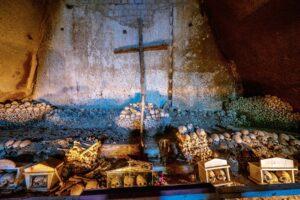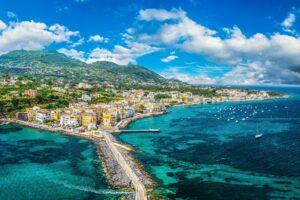Fodor's Expert Review Santa Chiara
Offering a stark and telling contrast to the opulence of the nearby Gesù Nuovo, Santa Chiara is the leading Angevin Gothic monument in Naples. The fashionable house of worship for the 14th-century nobility and a favorite Angevin church from the start, the church of St. Clare was intended to be a great dynastic monument by Robert d'Anjou. His second wife, Sancia di Majorca, added the adjoining convent for the Poor Clares to a monastery of the Franciscan Minors so she could vicariously satisfy a lifelong desire for the cloistered seclusion of a convent. This was the first time the two sexes were combined in a single complex. Built in a Provençal Gothic style between 1310 and 1328 (probably by Gagliardo Primario) and dedicated in 1340, the church had its aspect radically altered, as did so many others, in the Baroque period. A six-day fire started by Allied bombs on August 4, 1943, put an end to all that, as well as to what might have been left of the important cycle of frescoes by Giotto... READ MORE
Offering a stark and telling contrast to the opulence of the nearby Gesù Nuovo, Santa Chiara is the leading Angevin Gothic monument in Naples. The fashionable house of worship for the 14th-century nobility and a favorite Angevin church from the start, the church of St. Clare was intended to be a great dynastic monument by Robert d'Anjou. His second wife, Sancia di Majorca, added the adjoining convent for the Poor Clares to a monastery of the Franciscan Minors so she could vicariously satisfy a lifelong desire for the cloistered seclusion of a convent. This was the first time the two sexes were combined in a single complex. Built in a Provençal Gothic style between 1310 and 1328 (probably by Gagliardo Primario) and dedicated in 1340, the church had its aspect radically altered, as did so many others, in the Baroque period. A six-day fire started by Allied bombs on August 4, 1943, put an end to all that, as well as to what might have been left of the important cycle of frescoes by Giotto and his Neapolitan workshop. The church's most important tomb towers behind the altar. Sculpted by Giovanni and Pacio Bertini of Florence (1343–45), it is, fittingly, the tomb of the founding king: the great Robert d'Anjou, known as the Wise. Nearby are the tombs of Carlo, duke of Calabria, and his wife, Marie de Valois, both by Tino da Camaino.
Around the left side of the church is the Chiostro delle Clarisse, the most famous cloister in Naples. Complemented by citrus trees, the benches and octagonal columns comprise a light-handed masterpiece of painted majolica designed by Domenico Antonio Vaccaro, with a delightful profusion of landscapes and light yellow, azure, and green floral motifs realized by Donato and Giuseppe Massa and their studio (1742).
READ LESS







